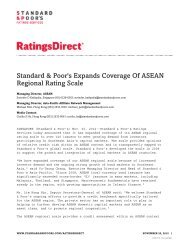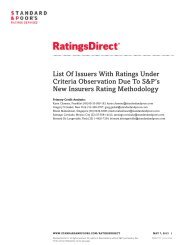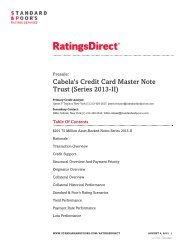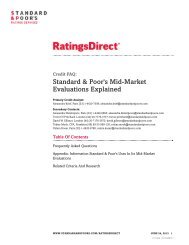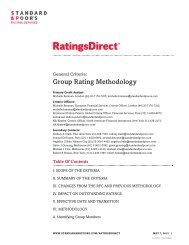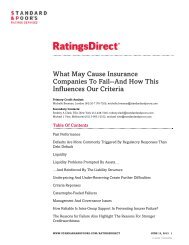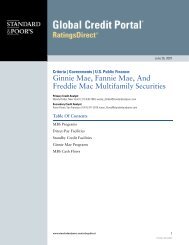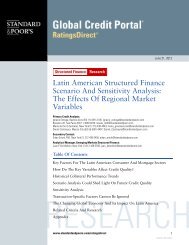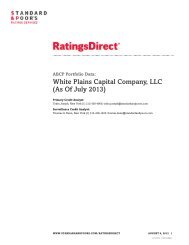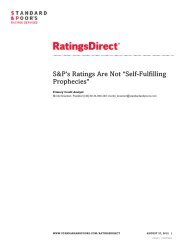Could SME-Backed Covered Bonds Gain ... - Standard & Poor's
Could SME-Backed Covered Bonds Gain ... - Standard & Poor's
Could SME-Backed Covered Bonds Gain ... - Standard & Poor's
You also want an ePaper? Increase the reach of your titles
YUMPU automatically turns print PDFs into web optimized ePapers that Google loves.
Credit FAQ:<strong>Could</strong> <strong>SME</strong>-<strong>Backed</strong> <strong>Covered</strong> <strong>Bonds</strong> <strong>Gain</strong>Popularity With Investors?At a time when public sector collateral for covered bonds is shrinking, issuers and investors are looking for new typesof collateral to back them. Increasingly, they are considering the possibility of using small and midsize enterprises(<strong>SME</strong>s). Some Turkish banks have already issued <strong>SME</strong>-backed covered bonds, and last year the first <strong>SME</strong>-backedcovered bond program was announced in Germany. In the U.S., too, draft covered bond legislation also proposes theuse of <strong>SME</strong>s as collateral for covered bonds. Here, we address some frequent investor queries regarding how we wouldrate <strong>SME</strong> covered bonds, and whether they have the potential to become widely accepted by the financial markets.Frequently Asked QuestionsWould <strong>Standard</strong> & <strong>Poor's</strong> need to establish a new rating methodology to rate an <strong>SME</strong>-backed coveredbond?Whatever the assets covered bonds use as collateral, we typically utilize our existing criteria to analyze the quality ofthese assets. Our aim is to ensure that, regardless of the structure of the collateral, we assess the asset risk in acomparable way. Depending on the type of <strong>SME</strong> exposures in <strong>SME</strong>-backed covered bonds, we would likely use ourmethodology and assumptions for assessing collateralized loan obligations (CLOs) backed by European <strong>SME</strong>s (forfurther details see "European <strong>SME</strong> CLO Methodology And Assumptions," published Jan. 10, 2013, on RatingsDirect onthe Global Credit Portal). If the cover pool exhibited characteristics more akin to collateralized debt obligations(CDOs), we would likely use our CDO criteria (see "Update To Global Methodologies And Assumptions For CorporateCash Flow And Synthetic CDOs," published Sept. 19, 2009). We therefore believe we already have the appropriatecriteria in place to analyze the asset risk in <strong>SME</strong>-backed covered bonds.What would an <strong>SME</strong> covered bond structure look like?In Europe, most covered bonds are issued under a legislative framework, which we believe reflects investorpreference. Currently, we're not aware of any European legislation that allows unsecured exposures to <strong>SME</strong>s to beeligible collateral for covered bonds. Any such covered bonds are therefore likely to be issued and structured similar toa standard <strong>SME</strong> transaction. To be considered a covered bond, we would expect such an issue to resemble an <strong>SME</strong>securitization, with the added benefit of a guarantee from the sponsoring bank, making it a dual-recourse debtinstrument, which typically allows the covered bond to be rated higher than the issuer's senior unsecured debt.Do you consider <strong>SME</strong> collateral to be materially different from mortgage collateral?In <strong>SME</strong> securitizations, collateral provided by usual <strong>SME</strong> lending activities might not be as straightforward to value ascollateral in existing mortgage- and public sector-backed covered bonds. When we rate <strong>SME</strong> securitizations, wetypically only attribute modest recovery expectations, even for exposures for which security is granted. Indeed,depending on the classification of the country-specific insolvency regimes, we might only assume average recoveriesfor (typically not mortgage) secured exposures--that means a 45% recovery likelihood in Germany or Austria, or 39%for <strong>SME</strong> collateral located in France, Italy, or Spain. By contrast, for mortgage-backed covered bond programs, weWWW.STANDARDANDPOORS.COM/RATINGSDIRECT FEBRUARY 4, 2013 21071666 | 300989331
Credit FAQ: <strong>Could</strong> <strong>SME</strong>-<strong>Backed</strong> <strong>Covered</strong> <strong>Bonds</strong> <strong>Gain</strong> Popularity With Investors?assume an average recovery of about 73%--almost twice the level of recoveries that we see for <strong>SME</strong> securitizations (forfurther details see: "Global <strong>Covered</strong> Bond Characteristics And Rating Summary Q3 2012," published Nov. 6, 2012).Do you see other risks beyond asset risk?When analyzing covered bonds under our existing covered bond criteria framework, we place a strong emphasis onasset liability mismatch (ALMM) risk--the risk that, if the original issuer defaults and is no longer able to makepayments on the bonds, the repayment profiles of the cover pool assets and the liabilities differ, resulting in potentialshortfalls to bondholders (for further details see: "<strong>Covered</strong> Bond Ratings Framework: Methodology And Assumptions,"published June 26, 2012). To allow us to rate the covered bonds based on the premise of full and timely payment ofinterest and principal according to their terms and conditions, we need to assess how likely and how expensive it is togenerate liquidity using the available collateral. This is particularly important if the amortization of the maturing bondis insufficient to repay interest and principal.To establish a likely price at which we believe cover assets can become monetized in a distressed environment, wetypically look at the widest observed spreads for securitizations or issuances of similar assets. However, we observethat <strong>SME</strong> covered issuances are currently not as liquid an asset class as collateral currently seen in covered bonds, andthat, furthermore, secondary market prices are not as readily available. Still, we believe that this might not necessarilyrepresent a constraint to rating <strong>SME</strong> covered bonds. In this new covered bond asset class, we've seen that issuers haveopted to differentiate not only by type of collateral, but also by payment structure. Indeed, the <strong>SME</strong> covered bondsseen to date feature a soft bullet structure, which, similar to securitizations, incorporates a "pass-through" mechanismthat reduces ALMM risk if the issuer defaults and fails to pay the bonds at maturity.In our analysis of traditional covered bonds, bullet repayments (where the covered bonds are repaid in full at maturity)typically result in a two-thirds attribution of required overcollateralization to market risk. Market risk results from theneed to liquidate/monetize covered assets within a relatively short timeframe to meet the scheduled redemptions. Asasset risk for <strong>SME</strong> transactions is typically higher than for pools of granular mortgages, reducing or even eliminatingmarket risk might no longer require us to factor it into our rating analysis. As a result, it's likely that theovercollateralization required to support the ratings in an <strong>SME</strong> transaction would not be dissimilar to that needed tosupport the ratings on current covered bonds with market risk.Given the challenges for <strong>SME</strong> covered bonds that you've outlined, do you believe they'll becomewidespread?We think it's likely that, over time, <strong>SME</strong> covered bonds could become as systemically important as traditional coveredbonds have become. First of all, <strong>SME</strong>s form the backbone of most European economies--they comprise more than99% of all European business, account for 67% of private sector employment, and generate half of European GDP,according to an EC report ("Are EU <strong>SME</strong>S Recovering From The Crisis? Annual Report On EU Small And MediumSized Enterprises 2010/2011, published by the European Commission.) Given that senior unsecured funding isbecoming more expensive for bank issuers, we believe that covered bonds backed by <strong>SME</strong> collateral could help thebanks to achieve funding advantages. Furthermore, we believe that funding the economy--which in Europe can beequalized with funding <strong>SME</strong>s--is high on the political agenda. Given that more "esoteric" assets are already eligiblecollateral, we consider it reasonable to expect that legislators may also introduce <strong>SME</strong>s into covered bond frameworksover time.WWW.STANDARDANDPOORS.COM/RATINGSDIRECT FEBRUARY 4, 2013 31071666 | 300989331
Credit FAQ: <strong>Could</strong> <strong>SME</strong>-<strong>Backed</strong> <strong>Covered</strong> <strong>Bonds</strong> <strong>Gain</strong> Popularity With Investors?We think investors may not find it as straightforward to compare the performance of <strong>SME</strong>-backed covered bonds withtraditional covered bonds. However, we believe that issuers' and rating agencies' regular, detailed, and transparentassessment of the composition of such covered bonds should facilitate a thorough understanding of <strong>SME</strong>-backedcovered bonds over time.Even more so than traditional covered bonds, <strong>SME</strong>-backed covered bonds will need to be established as a "creditproduct". With this in mind, investors are likely not to be as surprised if changes in the risks result in changes to theratings. We therefore believe <strong>SME</strong>-backed covered bonds have the potential to become widely accepted by investors,as has been the case for mortgage- and public sector-backed covered bonds.Related Criteria And Research• European <strong>SME</strong> CLO Methodology And Assumptions, Jan. 10, 2013• Update To Global Methodologies And Assumptions For Corporate Cash Flow And Synthetic CDOs, Sept. 19, 2009• <strong>Covered</strong> Bond Ratings Framework: Methodology And Assumptions, June 26, 2012• Global <strong>Covered</strong> Bond Characteristics And Rating Summary Q3 2012, published Nov. 6, 2012• Are EU <strong>SME</strong>S Recovering From The Crisis? Annual Report On EU Small And Medium Sized Enterprises2010/2011, published by the European Commission.(http://ec.europa.eu/enterprise/policies/sme/facts-figures-analysis/performance-review/pdf/2010_2011/are_the_eus_smes_reAdditional Contact:<strong>Covered</strong> <strong>Bonds</strong> Surveillance; <strong>Covered</strong>BondSurveillance@standardandpoors.comWWW.STANDARDANDPOORS.COM/RATINGSDIRECT FEBRUARY 4, 2013 41071666 | 300989331
Copyright © 2013 by <strong>Standard</strong> & <strong>Poor's</strong> Financial Services LLC. All rights reserved.No content (including ratings, credit-related analyses and data, valuations, model, software or other application or output therefrom) or any partthereof (Content) may be modified, reverse engineered, reproduced or distributed in any form by any means, or stored in a database or retrievalsystem, without the prior written permission of <strong>Standard</strong> & <strong>Poor's</strong> Financial Services LLC or its affiliates (collectively, S&P). The Content shall not beused for any unlawful or unauthorized purposes. S&P and any third-party providers, as well as their directors, officers, shareholders, employees oragents (collectively S&P Parties) do not guarantee the accuracy, completeness, timeliness or availability of the Content. S&P Parties are notresponsible for any errors or omissions (negligent or otherwise), regardless of the cause, for the results obtained from the use of the Content, or forthe security or maintenance of any data input by the user. The Content is provided on an "as is" basis. S&P PARTIES DISCLAIM ANY AND ALLEXPRESS OR IMPLIED WARRANTIES, INCLUDING, BUT NOT LIMITED TO, ANY WARRANTIES OF MERCHANTABILITY OR FITNESS FORA PARTICULAR PURPOSE OR USE, FREEDOM FROM BUGS, SOFTWARE ERRORS OR DEFECTS, THAT THE CONTENT'S FUNCTIONINGWILL BE UNINTERRUPTED, OR THAT THE CONTENT WILL OPERATE WITH ANY SOFTWARE OR HARDWARE CONFIGURATION. In noevent shall S&P Parties be liable to any party for any direct, indirect, incidental, exemplary, compensatory, punitive, special or consequentialdamages, costs, expenses, legal fees, or losses (including, without limitation, lost income or lost profits and opportunity costs or losses caused bynegligence) in connection with any use of the Content even if advised of the possibility of such damages.Credit-related and other analyses, including ratings, and statements in the Content are statements of opinion as of the date they are expressed andnot statements of fact. S&P's opinions, analyses, and rating acknowledgment decisions (described below) are not recommendations to purchase,hold, or sell any securities or to make any investment decisions, and do not address the suitability of any security. S&P assumes no obligation toupdate the Content following publication in any form or format. The Content should not be relied on and is not a substitute for the skill, judgmentand experience of the user, its management, employees, advisors and/or clients when making investment and other business decisions. S&P doesnot act as a fiduciary or an investment advisor except where registered as such. While S&P has obtained information from sources it believes to bereliable, S&P does not perform an audit and undertakes no duty of due diligence or independent verification of any information it receives.To the extent that regulatory authorities allow a rating agency to acknowledge in one jurisdiction a rating issued in another jurisdiction for certainregulatory purposes, S&P reserves the right to assign, withdraw, or suspend such acknowledgement at any time and in its sole discretion. S&PParties disclaim any duty whatsoever arising out of the assignment, withdrawal, or suspension of an acknowledgment as well as any liability for anydamage alleged to have been suffered on account thereof.S&P keeps certain activities of its business units separate from each other in order to preserve the independence and objectivity of their respectiveactivities. As a result, certain business units of S&P may have information that is not available to other S&P business units. S&P has establishedpolicies and procedures to maintain the confidentiality of certain nonpublic information received in connection with each analytical process.S&P may receive compensation for its ratings and certain analyses, normally from issuers or underwriters of securities or from obligors. S&Preserves the right to disseminate its opinions and analyses. S&P's public ratings and analyses are made available on its Web sites,www.standardandpoors.com (free of charge), and www.ratingsdirect.com and www.globalcreditportal.com (subscription) and www.spcapitaliq.com(subscription) and may be distributed through other means, including via S&P publications and third-party redistributors. Additional informationabout our ratings fees is available at www.standardandpoors.com/usratingsfees.WWW.STANDARDANDPOORS.COM/RATINGSDIRECT FEBRUARY 4, 2013 51071666 | 300989331




